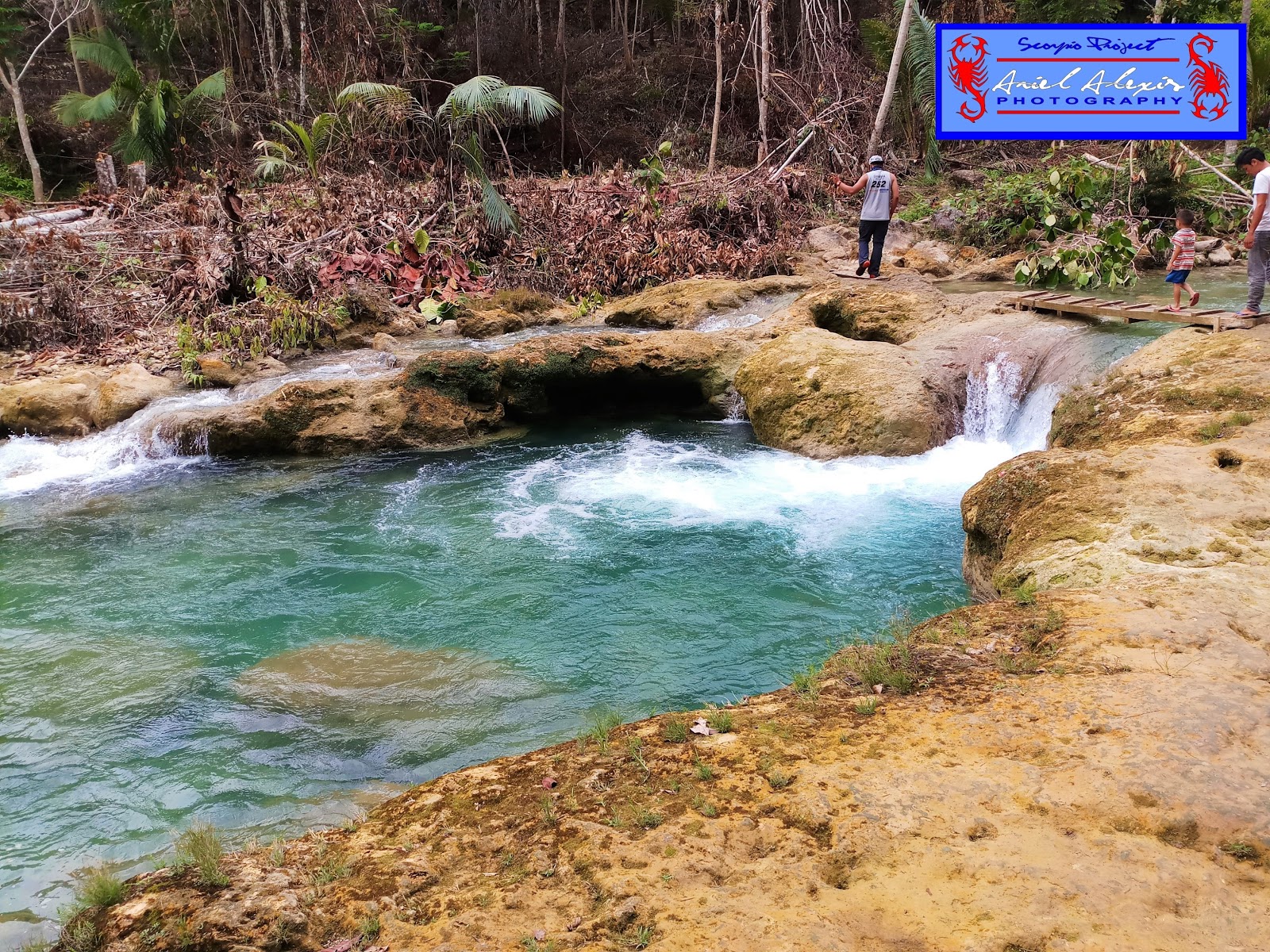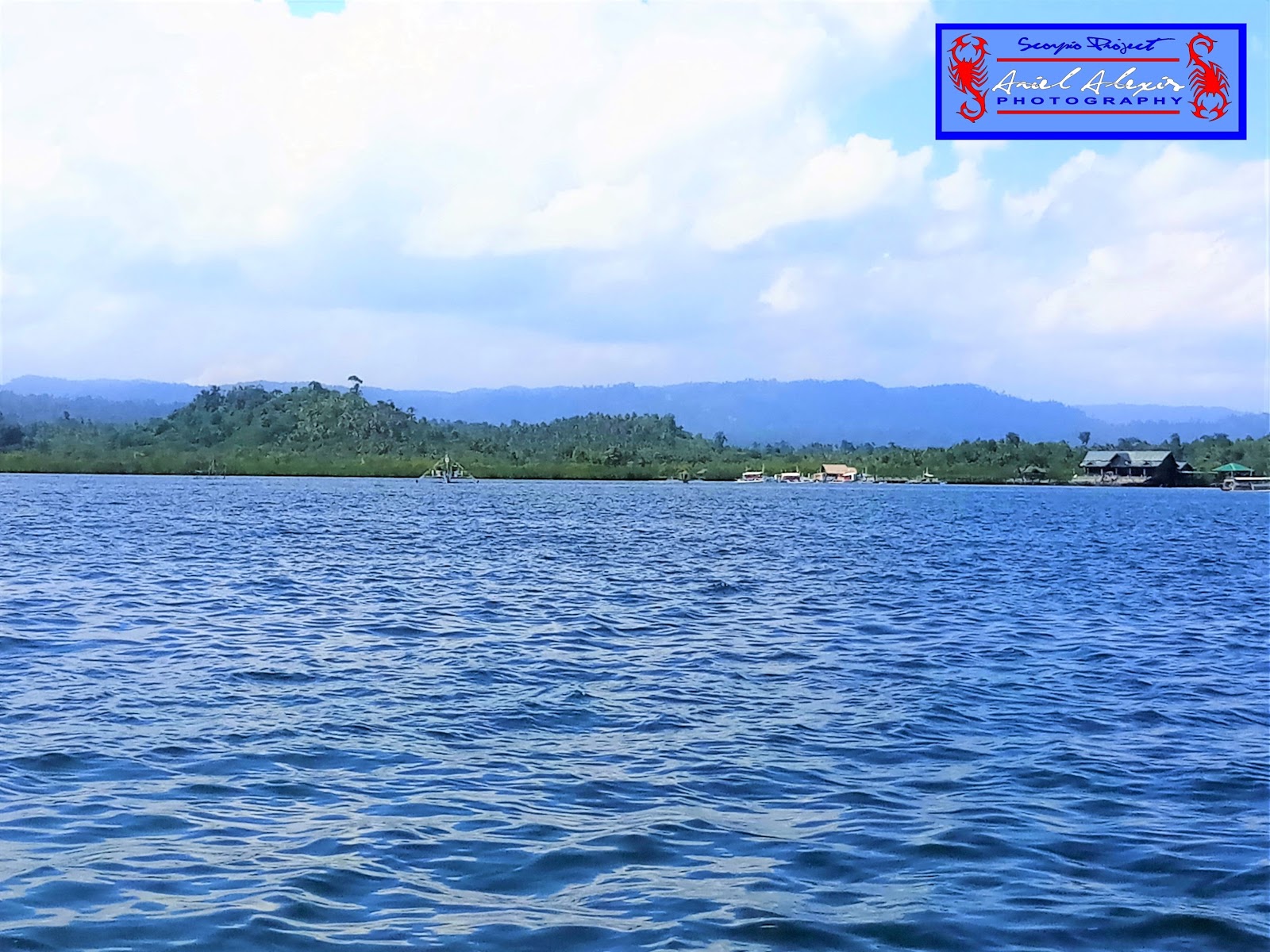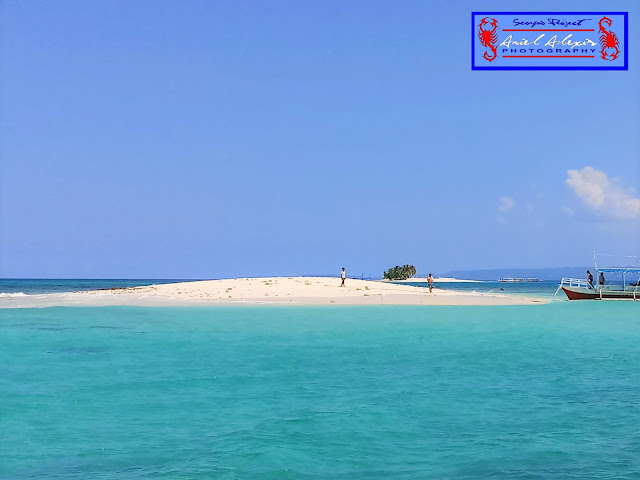“Beach
bumming” may not sound so exciting at first. But what if I say beach bumming
plus island hopping plus swimming in crystal-clear waters plus exploring
waterfalls plus watching sunrises and sunsets, and having the best summer
frolic of your life? Now that’s more exhilarating, right? Yes, these are just a
few of the thrill-filled things that beach bums like you and I can indulge during a
summer weekend wandering in Surigao del Sur!
 |
 |
| The creamy white sand beach of Cagwait |

 Pristine beaches with fine gray and creamy white sand, picture-perfect islands and islets, craggy hills and rock formations, mystical waterfalls, virgin forests and the like—these are among the stunning sceneries that greet weekend warriors who opt to spend their summer days in the province’s charming towns. It’s one place that’s oozing with refreshing rustic charms, a veritable slice of heaven here on earth!
Pristine beaches with fine gray and creamy white sand, picture-perfect islands and islets, craggy hills and rock formations, mystical waterfalls, virgin forests and the like—these are among the stunning sceneries that greet weekend warriors who opt to spend their summer days in the province’s charming towns. It’s one place that’s oozing with refreshing rustic charms, a veritable slice of heaven here on earth! |
| Sunset over Lianga Bay |

Lianga. Weekend wanderers looking for a small coastal town where almost everything is within walking and biking distance should visit Lianga. Not known to many, the quaint beach town has a few attractions that would give most people a reason to include it in their list of must-see places. It was my first time to explore it and I found Lianga a breath of fresh air literally!
 As it was a semi-spontaneous trip, I didn’t have any idea about what to expect during my quick visit. Surfing the Internet about Lianga didn’t yield much about what it offers to tourists. Fortunately, I heard from one of the staff of Big Times Beach Resort, where Jiu and I spent the night, that there’s this secluded attraction with a strange name—Ba-o Ba-o Falls!
As it was a semi-spontaneous trip, I didn’t have any idea about what to expect during my quick visit. Surfing the Internet about Lianga didn’t yield much about what it offers to tourists. Fortunately, I heard from one of the staff of Big Times Beach Resort, where Jiu and I spent the night, that there’s this secluded attraction with a strange name—Ba-o Ba-o Falls!
 As it was a semi-spontaneous trip, I didn’t have any idea about what to expect during my quick visit. Surfing the Internet about Lianga didn’t yield much about what it offers to tourists. Fortunately, I heard from one of the staff of Big Times Beach Resort, where Jiu and I spent the night, that there’s this secluded attraction with a strange name—Ba-o Ba-o Falls!
As it was a semi-spontaneous trip, I didn’t have any idea about what to expect during my quick visit. Surfing the Internet about Lianga didn’t yield much about what it offers to tourists. Fortunately, I heard from one of the staff of Big Times Beach Resort, where Jiu and I spent the night, that there’s this secluded attraction with a strange name—Ba-o Ba-o Falls! |
| Open air cottages in Lianga's Big Times Beach Resort |

 So, right after
breakfast, we decided to chase the cascade as we headed for the village of
Diatagon where it is situated. After making a few inquiries from the locals we
came across on our way there, we finally found it. From the highway, we passed
through a paved stretch that cuts across a small community inside a forested
area.
So, right after
breakfast, we decided to chase the cascade as we headed for the village of
Diatagon where it is situated. After making a few inquiries from the locals we
came across on our way there, we finally found it. From the highway, we passed
through a paved stretch that cuts across a small community inside a forested
area.
 You’d readily know that Ba-o Ba-o Falls is near once you reach the section of the road that’s surrounded by mahogany trees. The local government has also installed a huge billboard that greets visitors as they reach the point leading to the site. From the parking area, you’d have to walk down a flight of concrete stairs with iron railings—134 steps, if I’m not mistaken—and pass through a few rocky streams to get to the falls.
You’d readily know that Ba-o Ba-o Falls is near once you reach the section of the road that’s surrounded by mahogany trees. The local government has also installed a huge billboard that greets visitors as they reach the point leading to the site. From the parking area, you’d have to walk down a flight of concrete stairs with iron railings—134 steps, if I’m not mistaken—and pass through a few rocky streams to get to the falls. |
 |
 |
 |
 |
 |
 |
 |
 |

For me, it was worth all that little effort. Ba-o Ba-o may not be that magnificent nor massive as the other falls I’ve explored but it has a unique feature that had me at hello—I got to see not just one but two falls in one! The alluring twin falls is a photographer’s pleasure and its deep, cool pool is a diver’s delight. I’ll let the photos I’ve captured there do the rest of the talking for this wonder of nature. Truly, you shouldn’t dare miss the cascade whenever you get to visit Lianga.
 |
 |
 |
| First glimpse of the Britania Group of Islands |
 |
Spread
all over the crystal-clear waters of Lianga Bay, the islands and islets are
largely uninhabited, except for a few who have white-sand beaches. Out of the 24 islands scattered all over Lianga Bay, our guide told us that we’d only be visiting four—Hagonoy, Boslon, Naked and Hiyor-Hiyoran.
 |
 |
 |
 |
 |
 |
 |
 |
 |
| Tourists arriving in Hagonoy Island |
 |
| A sheltering nook in Hagonoy Island |
 Our first stop was at Hagonoy Island. This strip of land boasts of a pristine beach that is bedecked with coconut trees and some vegetation where you can laze around and seek shelter from the sun’s scorching heat.
Our first stop was at Hagonoy Island. This strip of land boasts of a pristine beach that is bedecked with coconut trees and some vegetation where you can laze around and seek shelter from the sun’s scorching heat.  To my chagrin, I suddenly realized after our boat landed that I failed to bring along my Nikon! Good thing, I had my Samsung J7 Plus safely tucked inside my waist bag. Otherwise, I wouldn't have any photo to share in this post! Hagonoy Island is definitely one picture-perfect subject for a shoot! I wouldn't mind spending the rest of the afternoon snapping pics there, but then again the other islands and islets were beckoning us.
To my chagrin, I suddenly realized after our boat landed that I failed to bring along my Nikon! Good thing, I had my Samsung J7 Plus safely tucked inside my waist bag. Otherwise, I wouldn't have any photo to share in this post! Hagonoy Island is definitely one picture-perfect subject for a shoot! I wouldn't mind spending the rest of the afternoon snapping pics there, but then again the other islands and islets were beckoning us.  |
| Sea urchins and seaweeds for sale in Hagonoy Island |
 |
| Hagonoy Island |
As Jiu and I went about exploring the island, I noticed a crowd of island hoppers gathering around a small group of peddlers under the shade of the trees. I got closer and saw what they were selling—guess what—fresh sea urchins and seaweeds! How's that for lunch of the exotic kind?
 |
 |
 |
 |
 |
 |
 |
 On our way to Boslon, our next stop, the guide informed that they couldn't bring us ashore as there was no place for them to dock the boat. The island was crawling with people that time, making it difficult to find
a safe landing spot. Ah, such a snag!
On our way to Boslon, our next stop, the guide informed that they couldn't bring us ashore as there was no place for them to dock the boat. The island was crawling with people that time, making it difficult to find
a safe landing spot. Ah, such a snag! 
Next on our list was Naked Island, which I thought was more of a sandbar rather than an island. We opted to skip that one, too, as there's practically nothing there (hence, the name!) to shield us from the sweltering heat that was at its fiercest at a little past one in the afternoon. I managed to snap a few pictures of it as our boat passed by.
Hiyor-Hiyoran Island
|
 |
 Last stop was at Hiyor-Hiyoran Island. It was also teeming with beach worshippers but our boatman managed to find us a secure place to land. Surrounded by swaying coconut trees and some vegetation, the island has a small white sand-beach where the tourists were flocking that time. Although it was a bit crowded that time, I was able to find me some space for some photoshoots.
Last stop was at Hiyor-Hiyoran Island. It was also teeming with beach worshippers but our boatman managed to find us a secure place to land. Surrounded by swaying coconut trees and some vegetation, the island has a small white sand-beach where the tourists were flocking that time. Although it was a bit crowded that time, I was able to find me some space for some photoshoots. |
| Hiyor-Hiyoran's powdery, creamy white sand |
 |
 |
 |
 |
 |
 |
All
told, I enjoyed my island-hopping experience in Britania to the hilt. Never
mind the hitches we encountered. When time and resources allow it, I want to go
back there and spend more time in some of the enchanting islets we didn’t get
to explore—and it’s going to be early in the morning before the summer sun gets
too hot for comfort!
 |
| Tandag Baywalk |
 Tandag. It’s been ages since I last visited the provincial capital so I couldn’t help but feel sentimental seeing it after quite some time. Yes, it was still the quaint town I first saw several years ago but much has also changed—for the better, that is. This, I believe, came about as a result of its conversion into a component city by virtue of Republic Act 9293 that was promulgated on June 23, 2007.
Tandag. It’s been ages since I last visited the provincial capital so I couldn’t help but feel sentimental seeing it after quite some time. Yes, it was still the quaint town I first saw several years ago but much has also changed—for the better, that is. This, I believe, came about as a result of its conversion into a component city by virtue of Republic Act 9293 that was promulgated on June 23, 2007.
 A
charming old town, Tandag has a history dating back to as far as 1609 when
Spanish missionaries, particularly Fr. Juan dela Vega, came and spread
Christianity among the natives who were composed mostly of Manobos and
Mamanwas. He then established a small community enclosed by a stone fort. Out
of this settlement rose what is now modern-day Tandag.
A
charming old town, Tandag has a history dating back to as far as 1609 when
Spanish missionaries, particularly Fr. Juan dela Vega, came and spread
Christianity among the natives who were composed mostly of Manobos and
Mamanwas. He then established a small community enclosed by a stone fort. Out
of this settlement rose what is now modern-day Tandag. |
| Entering Tandag City |
 Like
some of the coastal cities I’ve been to, Tandag has a seaside promenade
overlooking the vastness of the Philippine Sea. Similar to that of Manila’s Baywalk, the one in Tandag is wide and long,
serving as a hangout for the locals. At
night, the place is crawling with people who dine and drink at the row of
barbeque stalls and eateries lining up along half of its length. The other half
of Tandag Baywalk is an open space where kids can play to their hearts’ content
and adults can hang around and do their thing from sunup to sundown.
Like
some of the coastal cities I’ve been to, Tandag has a seaside promenade
overlooking the vastness of the Philippine Sea. Similar to that of Manila’s Baywalk, the one in Tandag is wide and long,
serving as a hangout for the locals. At
night, the place is crawling with people who dine and drink at the row of
barbeque stalls and eateries lining up along half of its length. The other half
of Tandag Baywalk is an open space where kids can play to their hearts’ content
and adults can hang around and do their thing from sunup to sundown.
Jiu
and I found the baywalk perfect for our shoots so we lingered there and took as
many snaps as we could. I also felt so relaxed when I was in that spot that morning. From where I sat on the seawall, I caught a glimpse
of desolate Magcagangi Island. For me, Tandag Baywalk captures the city’s
seaside charm more than anything else.
 |
| A glimpse of Magcagangi Island from Tandag Baywalk |
 From the baywalk, we searched for a resto offering fresh seafood for breakfast. Unfortunately, most of the stalls were closed as it was Good Friday when we came there. To my dismay, some were open but had either chicken, beef or pork dishes! Fortunately, we stumbled upon a lowly eatery at the public market that offered grilled fish and squid.
From the baywalk, we searched for a resto offering fresh seafood for breakfast. Unfortunately, most of the stalls were closed as it was Good Friday when we came there. To my dismay, some were open but had either chicken, beef or pork dishes! Fortunately, we stumbled upon a lowly eatery at the public market that offered grilled fish and squid. |
| The Twin Islands of Linungao |
 Passing
by Tandag Bridge, I asked Jiu to pull over at the end of the bridge so I can take some snaps at one of
the city’s prominent features—the Twin Islands of Linungao that tower over
Tandag.
Passing
by Tandag Bridge, I asked Jiu to pull over at the end of the bridge so I can take some snaps at one of
the city’s prominent features—the Twin Islands of Linungao that tower over
Tandag.  From what I’ve gathered the small and big islands are connected to the
city by a sandbar. Blessed with lush surroundings dominated by trees, bushes
and vines, Linungao is made of limestone and shiny stones whose cut edges are
said to be as sharp as a knife. Now, that’s one destination worth exploring
next time.
From what I’ve gathered the small and big islands are connected to the
city by a sandbar. Blessed with lush surroundings dominated by trees, bushes
and vines, Linungao is made of limestone and shiny stones whose cut edges are
said to be as sharp as a knife. Now, that’s one destination worth exploring
next time.  |
| The Twin Islands of Linungao |
Much as I wanted to linger in Tandag and get myself re-acquainted with it through my photowalks, I couldn’t stay long. So many attractions to see, so little time! One thing is sure though. I’m going back there in the immediate future as there’s so much about Tandag and the rest of the towns of Surigao del Sur that are worth discovering.
So,
weekend warriors, I exhort you to profess your love, admiration, and enthusiasm
for this country of 7,641 islands by visiting this fascinating province in
northeastern Mindanao. And I guarantee this: You won’t regret every single
moment spent there. As the heat rages on, make Surigao del Sur one of your top
choices for a summery vacay. Do it now before the throngs go there in a mad
rush ahead of you!






















